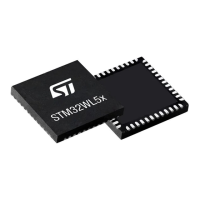True random number generator (RNG) RM0453
636/1454 RM0453 Rev 2
Post processing
In NIST configuration no post-processing is applied to sampled noise source. In non-NIST
configuration B (as defined in Section 22.6.2) a normalization debiasing is applied, i.e. half
of the bits are taken from the sampled noise source, half of the bits are taken from inverted
sampled noise source.
Conditioning
The conditioning component in the RNG is a deterministic function that increases the
entropy rate of the resulting fixed-length bitstrings output (128-bit). The NIST SP800-90B
target is full entropy on the output (128-bit).
The times required between two random number generations, and between the RNG
initialization and availability of first sample are described in Section 22.5: RNG processing
time.
Output buffer
A data output buffer can store up to four 32-bit words that have been output from the
conditioning component. When four words have been read from the output FIFO through
the RNG_DR register, the content of the 128-bit conditioning output register is pushed into
the output FIFO, and a new conditioning round is automatically started. Four new words are
added to the conditioning output register after a number of clock cycles specified in
Section 22.5: RNG processing time.
Whenever a random number is available through the RNG_DR register the DRDY flag
transitions from 0 to 1. This flag remains high until output buffer becomes empty after
reading four words from the RNG_DR register.
Note: When interrupts are enabled an interrupt is generated when this data ready flag transitions
from 0 to 1. Interrupt is then cleared automatically by the RNG as explained above.

